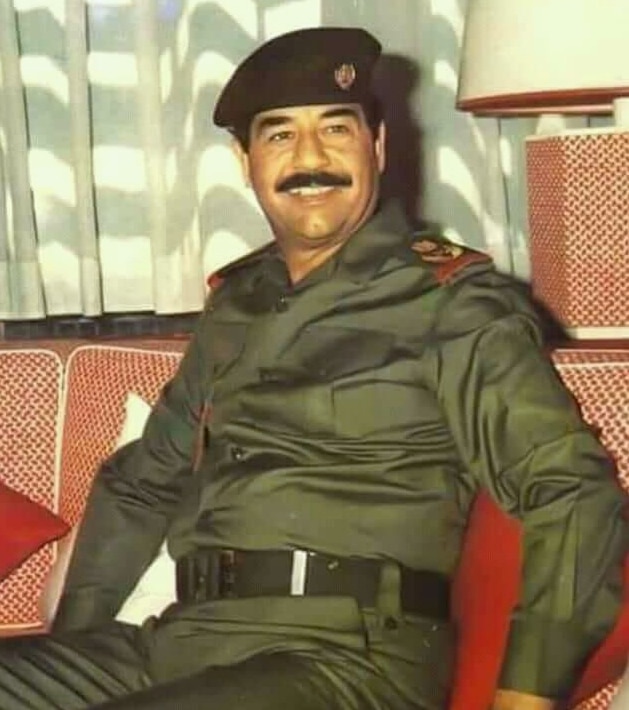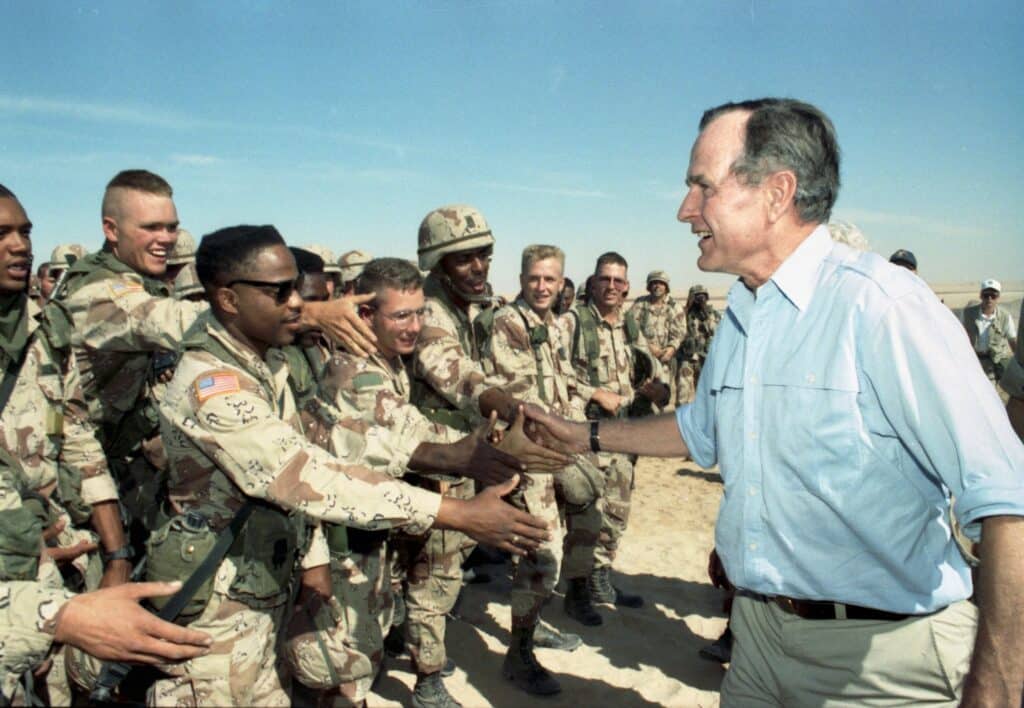This Week in History recalls memorable and decisive events and personalities of the past.
8th August 1990 – Iraq occupies and soon annexes Kuwait, triggering the outbreak of the Gulf War

A Kuwaiti M-84 tank during Operation Desert Shield
In 1979 Saddam Hussein, a general in the Iraqi government and a senior Iraqi politician, came to power after a brutal purge of the leadership of the ruling Iraqi Ba’ath Party. A Soviet ally, Iraq used the massive surge in oil prices during the 1973 oil crisis to both extensively expand its social welfare state and its military. Saddam, once in power, would create one of the world’s most brutal totalitarian regimes and build a cult of personality around himself.
Shortly after he had secured control of Iraq, a revolution broke out in neighbouring Iran in late 1978, which by 1979 had overthrown the pro-Western monarchy and replaced it with a radical Islamist theocratic republic.

Saddam Hussein [https://commons.wikimedia.org/w/index.php?curid=131708944]
Sensing weakness and hoping to expand Iraq’s oil reserves and Iraq’s control over the long-disputed Shatt al-Arab river, Saddam launched an invasion of Iran. His prize was Iran’s bordering oil-producing regions. As Saddam was an Arab-socialist Sunni, whilst most of Iraq were Shiite Muslims as in neighbouring Iran, he was also worried about the prospect of the Islamic revolution being spread to Iraq.

Ruhollah Khomeini rose to power after the Iranian Revolution
Saddam had even initially praised the Iranian theocracy, but the Iranians had rebuffed his calls for cooperation and called for an expansion of the Islamic revolution.
Iraq’s invasion of Iran sparked the horrifying nearly eight-year Iran-Iraq war, a long, grim conflict, which saw the use of chemical weapons by Iraq, massive suicidal human-wave attacks by Iran, including the use of child soldiers, and brutal trench warfare.

Some 95 000 Iranian child soldiers became casualties during the Iran–Iraq War, most of them between the ages of 16 and 17, with a few younger [http://www.sajed.ir/pe/components/com_joomgallery/img_originals/_9/Razmandegan-012.jpg, GFDL, https://commons.wikimedia.org/w/index.php?curid=8094125]
The war resulted effectively in a stalemate with neither side managing to defeat the other, and no changes to the border. Estimates vary, but the death toll was between 500 000 to a million, including 100 000 civilians.
During the war the Kurdish people of northern Iraq revolted against Saddam and after a brutal crackdown in 1988, the Iraqi army committed a genocide killing between 50 000 and 70 000 people.
During the war, the United States had provided limited support to both sides at different points in the conflict, in order to maintain the status quo in their relations.
By the end of the war, Iraq was in a shambles. Saddam’s government had avoided collapse, but it had only managed to do so through extreme brutality. Iraq had also borrowed huge sums of money from neighbouring oil-rich Kuwait and Saudi Arabia, and Saddam was becoming increasingly paranoid and insular.
Soon after the war, Saddam began to ask Kuwait and Saudi Arabia for debt forgiveness, appealing to Arab solidarity and claiming that Kuwait could not call a debt on their ‘Arab brothers’.
Iraq also began to assert its territorial claims to Kuwait, which dated back to the break-up of the Ottoman Empire, and also criticise Kuwait for producing too much oil, which in Iraq’s eyes was a deliberate attempt to suppress the Iraqi economy, which was extremely dependent on oil prices.
Negotiations continued between Iraq and Kuwait, with tensions only growing as both sides used increasingly incendiary rhetoric. According to Saddam during his interrogation after his capture in 2003, the final straw in relations between the two sides was during a closed meeting in 1990 when the Kuwaiti Emir threatened the Iraqi foreign minister that he would turn ‘every Iraqi woman into a $10 prostitute’ by bankrupting Iraq.
After the end of the Iran-Iraq war, the United States government had hoped to flip Iraq from being a Soviet ally into the American sphere of influence, and encouraged more trade with the Gulf States to achieve this. Plans quickly went awry as Iraqi human rights abuses against other Arabs as well as its threats against Kuwait saw the US adopt an increasingly critical line on Iraq.
In 1990, a manufactured dispute over an oil well saw Iraq demand Kuwait handover $10 billion, the majority of their debt to Kuwait as compensation, Kuwait offered only $500 million. On 2 August 1990, 88 000 troops of the Iraqi army invaded Kuwait. The Kuwaiti army numbering only 16 000 was caught completely by surprise.

Iraqi T-72 tanks in Kuwait City
After the destruction of most of their equipment and 420 casualties as well as the capture of most of their army, Kuwait’s government fled into exile. Soon after, Saddam annexed Kuwait into Iraq. By 8 August, Kuwait was effectively conquered.
The move caused panic across the Arab world. Saudi Arabia, which is Iraq’s southern neighbour, feared that its main oil-producing regions, just south of Kuwait, could be seized by Iraq. Iraq found itself diplomatically isolated as even the Soviet Union, France and India, all countries which had previously had good relations with Baghdad, criticised the invasion. On the day of the invasion the U.N. security council passed Resolution 660, which called for the total withdrawal of Iraqi forces to their positions on 1 August. All but one – 14 of the 15 – members of the council at the time, including Cuba and the Soviet Union, voted for this resolution. Only Yemen abstained, calling for more negotiations.
Sanctions were quickly applied to the Iraqi government and the United States decided to begin putting together a coalition of nations to intervene militarily. On 16 January 1991, the coalition of nations, mainly supported by the United States, Saudi Arabia and the United Kingdom, but also including countries as diverse as Poland, Pakistan, Niger, Denmark, and South Korea, launched an aerial bombing campaign of Iraqi forces.
The Iraqi army was one of the largest in the world, and was filled with veterans of the Iran-Iraq war. It was also reasonably well equipped with huge amounts of Soviet equipment purchased with its significant oil wealth. While most analysts expected a coalition victory, some commentators believed it could be a costly and difficult war and could become another Vietnam war for the US.
Iraq had over 3 700 Surface to air missile batteries, and the world’s 6th largest Airforce housed in large bunkers.

President Bush visiting American troops in Saudi Arabia on Thanksgiving Day, 1990
Some 956 600 coalition troops, of whom 700 000 were American would face off against 650 000 Iraqis, who had spent months digging in along the border with Saudi Arabia.
To the shock even of the Americans, coalition airpower absolutely annihilated the Iraqi army. During the intense 42-day bombardment of Iraqi troops before coalition ground forces intervened, the Iraqi Air Force was wiped out and huge sections of its army were destroyed.

American F-15Es parked in Saudi Arabia during Operation Desert Shield
When coalition troops finally engaged the weakened Iraqi forces, the Iraqis were slaughtered in numerous one-sided battles.
By 28 February 1991, the Iraqi army was withdrawing from Kuwait, having suffered around 35 000 dead, 75 000 wounded, over 100 000 captured. Thousands of tanks were destroyed.

Aerial view of destroyed Iraqi T-72 tank, BMP-1 and Type 63 armored personnel carriers and trucks on Highway 8 in March 1991
Coalition forces suffered 292 killed, 147 of whom were killed by Iraqi troops, and 776 wounded, with only 31 tanks destroyed.
The first Gulf War remains one of history’s most militarily successful campaigns.
If you like what you have just read, support the Daily Friend


